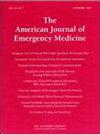格斗运动中的上肢损伤:来自美国急诊科的比较分析
IF 2.2
3区 医学
Q1 EMERGENCY MEDICINE
引用次数: 0
摘要
格斗运动在美国一直是流行的娱乐活动。尽管越来越受欢迎,但相对较少的研究描述了需要紧急医疗护理的战斗运动损伤的模式、类型和解剖分布。本研究提供了最新的描述性流行病学的上肢损伤持续格斗运动呈现给美国急诊科。方法:本研究分析了来自美国消费者产品安全委员会国家电子伤害监测系统(NEISS, 2003-2022年)的全国代表性数据库的回顾性数据。n = 12,619例损伤符合纳入标准,用于分析损伤类型和受伤的身体区域、特定战斗运动(摔跤、拳击、其他武术)的影响、人口统计学变量(年龄、性别)、报告的医院类型和随时间的变化。统计方法包括卡方检验、逻辑回归分析和比值比推导。结果摔跤伤害占报告伤害的49.4%,拳击占26.2%,武术占24.4%。骨折(46.5%)是最常见的损伤类型,其次是拉伤/扭伤(40.7%),然后是脱位(12.7%)。肩部(28.0%)是最常见的损伤部位,其次是手指(16.8%)和手部(16.4%)。年龄、性别和报告的医院类型因运动而异。结论:本研究表明摔跤、拳击和武术运动中受伤的模式和部位存在显著差异。通过提供有关拳击、摔跤和武术上肢颞部趋势和损伤模式的最新见解,本研究可能有助于在美国继续获得兴趣的一组运动中继续推进安全措施,并提高急诊医师为这些运动员提供护理的效率和效果。本文章由计算机程序翻译,如有差异,请以英文原文为准。
Upper extremity injuries in combat sports: A comparative analysis from US emergency departments
Background
Combat sports continue to be popular recreational activities in the United States (US). Despite increasing popularity, relatively few studies have characterized patterns, types, and anatomic distributions of combat sport injuries requiring emergency medical care. This study provides updated descriptive epidemiology of upper extremity injuries sustained from combat sports presenting to US emergency departments.
Methods
The study analyzes retrospective data from a nationally representative database, the US Consumer Product Safety Commission's National Electronic Injury Surveillance System (NEISS; years 2003–2022). A sample of n = 12,619 injuries met inclusion criteria and were included for analysis of injury types and injured body regions, effects of specific combat sport (wrestling, boxing, other martial arts), demographic variables (age, gender), reporting hospital type, and variation over time. Statistical methods included chi square tests, logistic regression analysis, and derivation of odds ratios.
Results
Wrestling accounted for 49.4 % of reported injuries, with boxing making up 26.2 %, and martial arts 24.4 %. Fractures (46.5 %) were the most common injury type, followed by strains/sprains (40.7 %) and then dislocations (12.7 %). Shoulders (28.0 %) were most commonly injured, followed by fingers (16.8 %) and hands (16.4 %). Age, gender, and reporting hospital type varied between sports.
Conclusions
This study demonstrates significant variability in pattern and location of injuries sustained from wrestling, boxing, and martial arts. By providing updated insight regarding upper extremity temporal trends and injury patterns in boxing, wrestling, and martial arts, this study may assist in efforts to continue advancing safety measures in a group of sports that continues to gain interest in the US, as well as improve the efficiency and effectiveness of care provided to these athletes by emergency medicine physicians.
求助全文
通过发布文献求助,成功后即可免费获取论文全文。
去求助
来源期刊
CiteScore
6.00
自引率
5.60%
发文量
730
审稿时长
42 days
期刊介绍:
A distinctive blend of practicality and scholarliness makes the American Journal of Emergency Medicine a key source for information on emergency medical care. Covering all activities concerned with emergency medicine, it is the journal to turn to for information to help increase the ability to understand, recognize and treat emergency conditions. Issues contain clinical articles, case reports, review articles, editorials, international notes, book reviews and more.

 求助内容:
求助内容: 应助结果提醒方式:
应助结果提醒方式:


